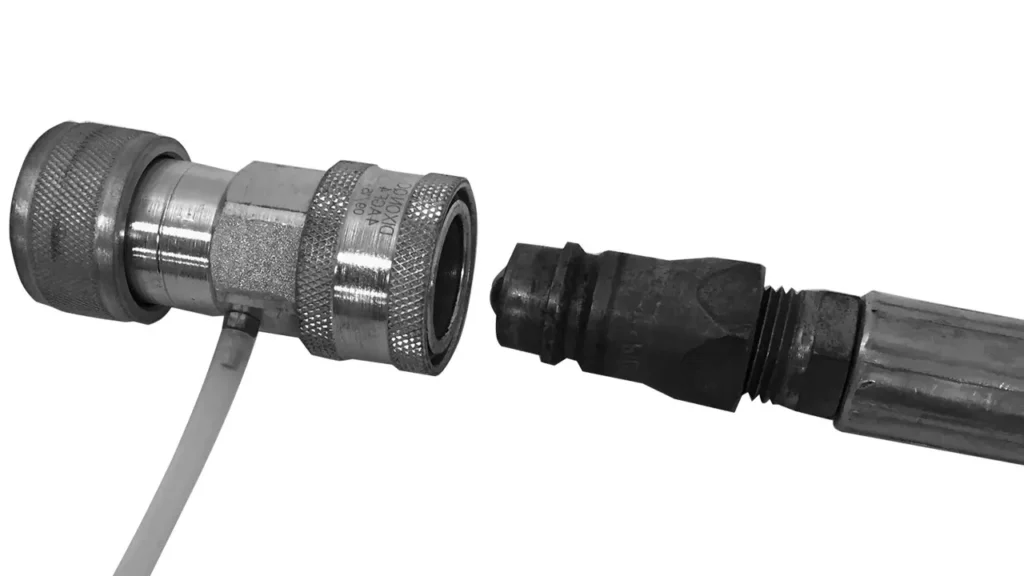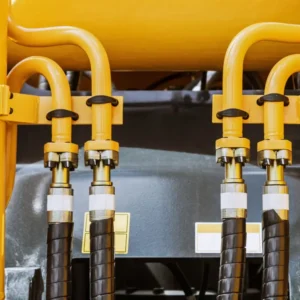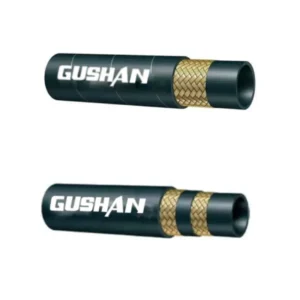Hydraulic systems operate under high pressure, and improper handling can lead to serious accidents. Knowing how to safely release pressure from a hydraulic hose is crucial for anyone working with hydraulic equipment.
In this guide, we’ll walk you through the step-by-step process of safely releasing pressure from a hydraulic hose, ensuring your safety and the longevity of your equipment.
How to Release Pressure from a Hydraulic Hose

Safety First:
- Always wear appropriate safety gear, including safety glasses, gloves, and protective clothing.
- Ensure the hydraulic system is turned off and isolated.
- Never attempt to release pressure while the system is still running.
Step-by-Step Guide:
Step 1: Identify Pressure Relief Valves:
Locate the Valve: Look for a pressure relief valve on the hydraulic pump, control valves, or directly on the hydraulic hose. These valves are often marked with a pressure rating or a symbol. Understand Valve
Type: Identify whether the valve is manually operated or automatically actuated. Manual valves require physical intervention to release pressure, while automatic valves respond to pressure increases.
Consult the Operator’s Manual: Refer to the specific manual for your hydraulic system to locate the correct relief valves and understand their operation.
Step 2: Activate Relief Valves Gradually:
Manual Activation:
- If the valve is manually operated, use a wrench or lever to slowly open it.
- Gradually release the pressure to avoid sudden pressure surges.
Automatic Relief Valves:
- Ensure the system is designed to automatically release pressure when necessary.
- Monitor the pressure gauge to confirm that the pressure is decreasing.
Safety Precautions:
- Wear appropriate safety gear, such as safety glasses and gloves.
- Stand clear of the release point to avoid potential fluid spray.
Step 3: Check for Residual Pressure
Use a Pressure Gauge: Connect a pressure gauge to the hydraulic system to accurately measure the residual pressure.
Manual Pressure Check: Carefully feel the hose and fittings for any residual pressure. Be cautious and avoid touching high-pressure components.
Use a Pressure Release Tool: Employ a specialized tool to bleed off any remaining pressure. These tools are designed to safely release pressure without causing damage.
Visual Inspection: Check for any leaks or signs of damage to the hose and fittings.
Step 4: Disconnect the Hose:
Wear Protective Gear: Ensure you’re wearing appropriate safety gear, including gloves and safety glasses.
Gradual Disconnection: Slowly loosen the fittings to release any residual pressure. Avoid sudden movements that could cause fluid to spray.
Clean Up: Use absorbent materials to clean up any spilled hydraulic fluid. Proper cleanup prevents slips and environmental contamination.
Inspect the Hose: Before storing or reusing the hose, inspect it for damage, wear, or cracks. Replace any damaged hoses.
Additional Tips:
- Consult the Operator’s Manual: Refer to the specific manual for your hydraulic system to understand the correct procedures for pressure release.
- Regular Maintenance: Schedule regular maintenance checks to ensure the proper functioning of pressure relief valves and other safety features.
- Training and Certification: Ensure that personnel working with hydraulic systems are properly trained and certified.
By following these guidelines and prioritizing safety, you can effectively and safely release pressure from hydraulic hoses, minimizing the risk of accidents and injuries.
Additional Tips:
- Use a Pressure Release Tool: For added safety, consider using a dedicated pressure release tool. These tools are designed to safely bleed off pressure from hydraulic hoses and fittings.
- Consult the Manufacturer‘s Manual: Refer to the specific instructions provided by the equipment manufacturer for the safest and most effective method of pressure release.
- Regular Maintenance: Regular maintenance of hydraulic systems can help prevent pressure buildup and ensure safe operation.
By following these steps and taking necessary precautions, you can safely release pressure from a hydraulic hose and reduce the risk of accidents.
Hydraulic Hose Pressure Release Tools
Hydraulic hose pressure release tools are designed to safely and efficiently release residual pressure from hydraulic hoses and couplings. These tools are essential for preventing accidents and injuries during maintenance, repair, or disconnection of hydraulic systems.
Types of Pressure Release Tools
- Manual Pressure Release Tools:
- Poppet-Style Tools: These tools are designed to engage the poppet valve in a hydraulic coupling, allowing the pressure to be released.
- Screw-Type Tools: These tools use a screw mechanism to gradually release pressure from the coupling.
- Lever-Action Tools: These tools utilize a lever to actuate a mechanism that releases the pressure.
- Hydraulic Pressure Release Tools:
- These tools use hydraulic power to release pressure from high-pressure hydraulic systems. They are often used in industrial settings where high-pressure hoses are common.
Key Considerations When Choosing a Pressure Release Tool:
- Compatibility: Ensure the tool is compatible with the type of hydraulic coupling you are working with.
- Safety: The tool should have safety features to prevent accidental activation and protect the user from injury.
- Durability: The tool should be made of high-quality materials to withstand the rigors of use.
- Ease of Use: The tool should be easy to operate and maintain.
Always follow the manufacturer‘s instructions when using a hydraulic hose pressure release tool.
By using the appropriate pressure release tool, you can safely and efficiently work on your hydraulic system, minimizing the risk of accidents and injuries.
Hydraulic Hose Quick Release Couplings
Hydraulic hose quick release couplings are essential components in many industries, enabling fast and efficient connections and disconnections of hydraulic hoses. These couplings streamline operations, reduce downtime, and enhance safety.
How Hydraulic Hose Quick Release Couplings Work
A typical quick release coupling consists of two main parts: the coupler and the nipple. To connect the two:
- Alignment: The coupler and nipple are aligned.
- Connection: The coupler is pushed onto the nipple, engaging a locking mechanism.
- Seal: A seal is formed between the two parts, preventing fluid leakage.
To disconnect, a simple release mechanism is activated, usually by pulling a lever or pushing a button.
Types of Quick Release Couplings
- Flat-Face Couplings:
- Designed for quick and easy connection and disconnection.
- Ideal for low-pressure applications.
- Ball Lock Couplings:
- Provide a secure connection, even under high pressure.
- Commonly used in heavy-duty applications.
- Poppet Valve Couplings:
- Prevent fluid leakage during disconnection, ensuring safety.
- Ideal for applications where fluid containment is critical.
Key Considerations for Selection
- Pressure Rating: Ensure the coupling can withstand the maximum pressure of your hydraulic system.
- Flow Rate: Choose a coupling with a sufficient flow capacity to meet your application’s requirements.
- Material Compatibility: Select a coupling made of materials compatible with your hydraulic fluid.
- Environmental Factors: Consider the operating environment, such as temperature and exposure to contaminants.
- Ease of Use: A user-friendly design can significantly improve efficiency.
- Safety Features: Look for couplings with safety features like automatic shutoff valves to prevent accidental fluid release.
Benefits of Using Quick Release Couplings
- Increased Efficiency: Quick and easy connections and disconnections save time and labor.
- Reduced Downtime: Minimize downtime during maintenance and repairs.
- Improved Safety: Prevent accidental fluid leaks and injuries.
- Enhanced Productivity: Streamline operations and boost productivity.
By understanding the types, benefits, and key considerations of hydraulic hose quick release couplings, you can select the right components for your specific application and improve the overall efficiency and safety of your hydraulic system.
Conclusion
Releasing pressure from a hydraulic hose is a critical safety measure that should always be performed carefully. By following the steps outlined in this guide, you can safely and efficiently depressurize your hydraulic system.
Remember: Always prioritize safety and use appropriate safety equipment when working with hydraulic systems.
Need Hydraulic Hoses?
Contact us today for a quote!
Our team of experts can help you select the right hydraulic hose for your specific application. We offer a wide range of high-quality hoses, fittings, and accessories to meet your needs.
Let us help you keep your hydraulic systems running smoothly.



